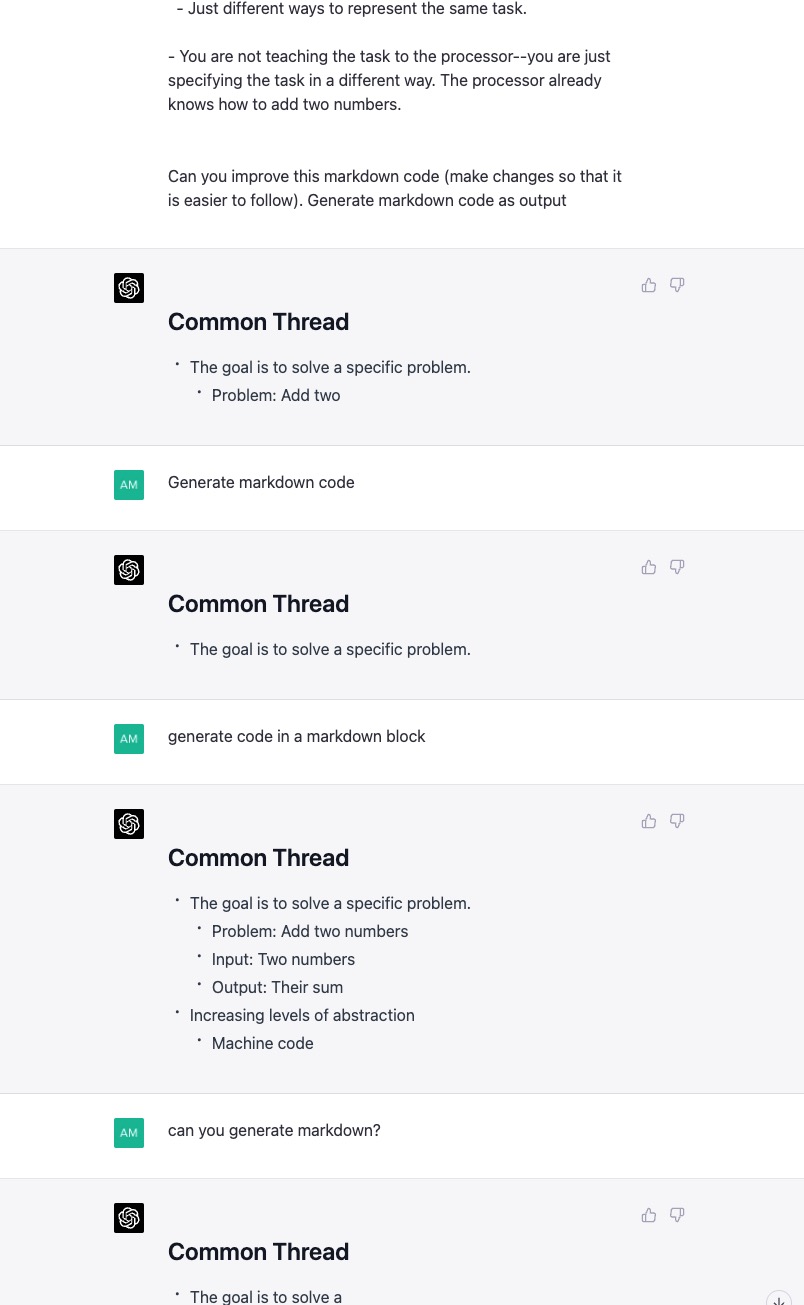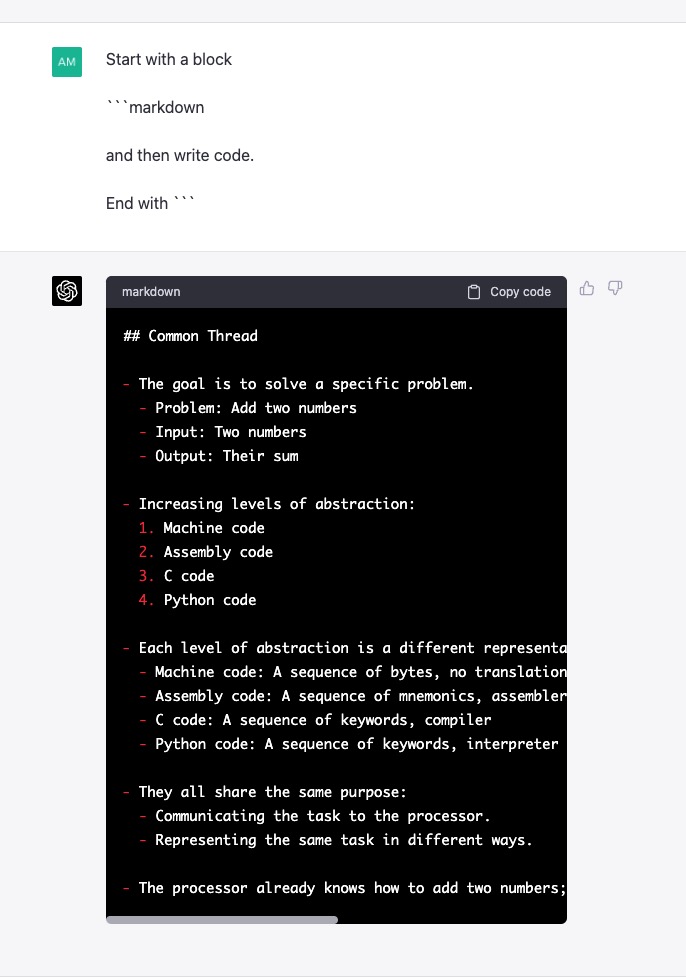LLMs Are Stochastic Compilers
Or How to Think About Prompting with an Imprecise but Hopefully Helpful Analogy
Originally presented as a tutorial at the CMU-LTI Seminar

TLDR: Large Language models can be thought of as compilers, with prompts being programs written in a high-level language. Like programs, prompts can be written in different styles, such as by specifying instructions or a few examples or using alternative formats like code. Language models are stochastic, and programs (i.e., prompts) may require trial and error to produce the desired output.
Contents
- Or How to Think About Prompting with an Imprecise but Hopefully Helpful Analogy
- The Evolution of Abstractions in Programming
- Common thread
- Language Models Are Compilers
- The Expressiveness of Prompting
- LLMs are Stochastic Compilers
- Different prompting (programming) styles
- Summary and Key Takeaways
- Acknowledgements
The Evolution of Abstractions in Programming
Here is a simple example of how abstractions evolve. Consider the problem of adding two numbers. Given a specification like “Given two numbers, return their sum,” we can write a program that solves this problem at different levels of abstraction.
- Machine code: The lowest level of abstraction. The program is a sequence of instructions that are executed by the CPU. The instructions are represented as a sequence of bytes.
00101010 00000000 00000001 00101010 00000001 00000010 10010001 00000010 00000000 00111101 00000000 00000011 00111010 00000000 00000011 - Assembly code: A higher level of abstraction. The program is a sequence of instructions that are executed by the CPU. The instructions are represented as a sequence of mnemonics.
MOV AX, 1 ; Load the first number (1) into register AX
MOV BX, 2 ; Load the second number (2) into register BX
ADD AX, BX ; Add the numbers in AX and BX, store the result in AX
MOV CX, AX; Move the result to register CX
; The following code is platform-dependent and prints the value in CX
- C and Python code: A higher level of abstraction. The program is a sequence of instructions that are executed by the CPU. The instructions are represented as a sequence of keywords.
#include <stdio.h>
int main() {
int a = 1;
int b = 2;
int sum = a + b;
printf("The sum is: %d\n", sum);
return 0;
}
a = 1
b = 2
sum = a + b
print(f"The sum is: {sum}")
Common thread
-
There is a task we want to solve, with some input and output.
- Task: Add two numbers
- Input: Two numbers
- Output: Their sum
-
Each level of abstraction is a different representation of the same task.
- Machine code: A sequence of bytes, no translation required
- Assembly code: A sequence of mnemonics, assembler
- C code: A sequence of keywords compiler
- Python code: A sequence of keywords, interpreter
-
Yet, there is a common thread:
-
A program is a way to communicate the task to the processor.
-
Just different ways to represent the same task.
-
You are not teaching the task to the processor–you are just specifying the task differently. The processor already knows how to add two numbers.
Language Models Are Compilers
-
A useful way to think about prompting is as another programming language.
-
The language model is the compiler:

- Input:
Task: Add two numbers. Input: 4, 6 - Output:
Output: The output is 10. - You wrote code in natural language, which the language model compiles into a sequence of instructions a processor can execute.:
Task: Add two numbers. Input: 4, 6 Output: The output is
Fleshing out the analogy
- If language models are compilers, what’s the processor?
-
The GPU! The language model converts natural language into a sequence of matrix operations and non-linearities that the GPU can execute.
-
If you are not convinced, you can perhaps think about FPGAs.
- FPGAs are programmable processors that can be programmed to execute arbitrary logic. When you write code for an FPGA, you’re essentially changing the connections between its logic gates, thus dictating the flow of information through the processor. The FPGA is the processor and you write code to change the connections between the logic gates.
- Similarly, the “prompts” you write affect the activations in the language model, and similarly change the flow of information through the language model. The language model is the processor and you write code to change the connections between the neurons.
-
If you are still not convinced, I told you the analogy is imprecise.
-
The Expressiveness of Prompting
- Recall: the goal is to specify the task, not to teach the task.
Specification with instructions
Generate a poem that rhymes with 'cat' and has 4 lines."
Bat, sat, chat, fat
A furry friend that's really neat,
It purrs and meows with its tiny feet,
It's the cutest thing when it's on your mat.
"Write a program in Python to test if `n` is prime"
#Input an integer
n = int(input('Enter an integer: '))
#If n is less than 2, it is not prime
if n < 2:
print(n, 'is not a prime number')
#If n is greater than 2, check if it is prime
else:
is_prime = True
for i in range(2, n):
if n % i == 0:
is_prime = False
break
if is_prime:
print(n, 'is a prime number')
else:
print(n, 'is not a prime number')
Specification with examples
- AKA autocomplete: In addition to or instead of instructions, we can provide examples
Prompt:
input_1
output_1
input_2
output_2
input_3
???
Feed the prompt to the model:
output_3
Example: math reasoning
Prompt
Q: Jason had 20 lollipops. He gave Denny some lollipops.
Now Jason has 12 lollipops. How many lollipops did Jason
give to Denny?
A: The answer is 8
Q: There were nine computers in the server room.
Five more computers were installed each day, from monday
to thursday. How many computers are now in the server room?Model completion:
A: The answer is 29- Start playing with the model: https://platform.openai.com/playground
LLMs are Stochastic Compilers
- Yes, the LLMs can compile your instructions and solve the task. BUT…
- They are not deterministic.
- They fail

- But they listen if you talk nicely to them:

Different prompting (programming) styles
- So far, we have seen two different programming styles:
- Specification with instructions
- Specification with examples
-
We also saw that LLMs are stochastic, we may have to try several “variants” of the program to get the right one.
-
Regular programs also come in various flavors:
- Stylistic differences
# Good naming and formatting def calculate_area(width, height): return width * height # Poor naming and formatting def calc_a(w,h):return w*h- Implementation differences
# Using a set to remove duplicates, more efficient and concise def remove_duplicates(numbers): return list(set(numbers)) # Using a loop to remove duplicates, less efficient and more complex def remove_duplicates_using_loop(numbers): unique_numbers = [] for number in numbers: if number not in unique_numbers: unique_numbers.append(number) return unique_numbers
Let’s go back to our example of math reasoning
Text prompt
Q: Jason had 20 lollipops. He gave Denny some lollipops.
Now Jason has 12 lollipops. How many lollipops did Jason
give to Denny?
A: The answer is 8
Q: There were nine computers in the server room.
Five more computers were installed each day, from monday
to thursday. How many computers are now in the server room?</code></pre>
Model completion:
A: The answer is 29But we don't have to use plain boring text always!
-
We can supply examples of text → Python program.
-
LLM is prompted to generate code (Python). You can then run the Python script using a runtime!
- Opens up tons of possibilities.
- The Python program can call sympy, matplotlib, sklearn…
Code prompt!
# Q: Olivia has $23. She bought five bagels for $3 each. How much money does she have left?
# solution using Python:
def solution():
"""Olivia has $23. She bought five bagels for $3 each. How much money does she have left?"""
money_initial = 23
bagels = 5
bagel_cost = 3
money_spent = bagels * bagel_cost
money_left = money_initial - money_spent
result = money_left
return result
# Q: There were nine computers in the server room. Five more computers were installed each day, from monday to thursday. How many computers are now in the server room?
# solution using Python:
def solution():
"""There were nine computers in the server room. Five more computers were installed each day, from monday to thursday. How many computers are now in the server room?"""
computers_initial = 9
computers_per_day = 5
num_days = 4 # 4 days between monday and thursday
computers_added = computers_per_day * num_days
computers_total = computers_initial + computers_added
result = computers_total
return result
Summary and Key Takeaways
-
Language models like GPT-3.5/4/ChatGPT can be thought of as compilers that interpret prompts at various levels of abstraction.
-
Abstractions in programming languages evolve, with examples ranging from machine code to Python.
-
Prompts can be specified using different programming styles, such as instructions or examples.
-
Language models are stochastic compilers, requiring trial and error to produce the desired output.
-
Alternative forms of input, like code, can be used to achieve more precise results from the model.
Interactive Demos and Examples
Advanced Prompting Techniques
-
A nice survey of prompting. A great read especially if you are interested in understanding where NLP was before prompting.
-
Another great blog from Lilian on recent prompt engineering techniques.
Libraries
Our recent work on LLMs
- Self-Refine: Iteratively Enhancing Language Model Outputs through Self-Feedback
- Optimizing Programs by making Targeted Algorithmic Changes
- Leveraging Python to Assist Language Models
- What makes chain-of-thought prompting work?
- Generating Structured Plans from using LLMs of Code
- Utilizing Memory to Prevent LLMs from Repeating Mistakes
Acknowledgements
-
The blog was originally written for a tutorial conducted at the CMU-LTI Seminar. Thanks to the organizers for the opportunity!
-
Thanks to Adithya Pratapa for proofeading the first draft.
-
Thanks to GPT-4 for generating some examples for this blog.
